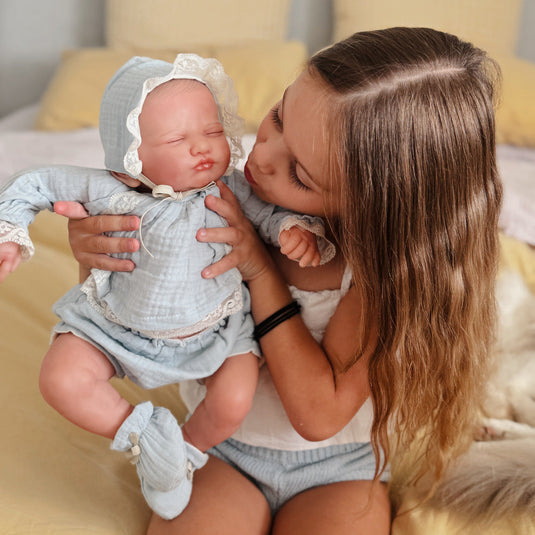6 Easy Facts About Dolls And Accessories Described
6 Easy Facts About Dolls And Accessories Described
Blog Article
Dolls And Accessories - The Facts
Table of ContentsNot known Incorrect Statements About Dolls And Accessories A Biased View of Dolls And AccessoriesWhat Does Dolls And Accessories Mean?The Best Guide To Dolls And AccessoriesTop Guidelines Of Dolls And AccessoriesThe Only Guide for Dolls And AccessoriesThe Facts About Dolls And Accessories Uncovered
When dolls are consisted of in team play, youngsters practice waiting, sharing, and paying attention to others' concepts. Whether they're pretending to be a parent, sibling, or friend, youngsters discover just how relationships workhow to support others, address disagreements, and look after somebody else. These very early role-play experiences come to be the groundwork for healthy friendships and connections later on in life.Repeating soothing routines with a doll (feeding, rocking, putting to bed) can help children really feel calm and safe. Taking care of a doll can make a kid really feel qualified and certain.
Fascination About Dolls And Accessories
When youngsters see dolls that reflect their race, heritage, and society, it strengthens a favorable feeling of identity. Dolls also present kids to cultures outside their own, building respectful curiosity and compassion for others.
As Dr. Karyn Purvis, a leader in child growth and trauma-informed treatment, once said: This powerful quote highlights just how play isn't simply funit's exactly how youngsters discover best. The mind cords itself through repetition. When a youngster is involved, happy, and emotionally linked to an activitylike doll playthe brain reinforces those links quicker and extra meaningfully.
The Definitive Guide to Dolls And Accessories

Young boys require compassion, compassion, and creativity tooand doll play uses that. Yesdolls supply something one-of-a-kind. They motivate flexible storytelling and psychological link in a method couple of other playthings do. Dolls are usually a kid's very first "buddy," assisting them exercise connections, develop communication abilities, and really feel comforted. Children create their feeling of self from a young age.
The 25-Second Trick For Dolls And Accessories
With dolls that matter. Samantha Ong Samantha Ong is the owner of Joeydolls, a Canadian-based plaything brand on a goal to commemorate Oriental societies through happy, inclusive play. Inspired by her very own experiences expanding up without cultural representation, Samantha develops dolls that assist youngsters feel honored of who they are while triggering inquisitiveness and compassion in others.
Playing with dolls encourages children to chat even more concerning others' thoughts and feelings, a research has located. The study recommends that playing fictional games with dolls might aid kids develop social skills, theory of mind and empathy.
The smart Trick of Dolls And Accessories That Nobody is Discussing
They were also most likely to deal with the dolls in the second individual, speaking with them straight, whereas the characters on the computer display they had a tendency to refer to in the third person. No difference was observed between children and women."Inner state language can indicate that a child is considering other people's thoughts and emotions while playing with dolls," claimed Gerson.
And that they see language use in this respect is excellent confirmation of the hypothesis."Mardell included that the searchings for ought to apply to any type of kind of role-play toy, instead than being specific to Barbies."Children usually start to reveal indicators of interior state language around the age of 4.
The Ultimate Guide To Dolls And Accessories
"It comes to be important for making and sustaining friendships, and exactly how they pick up from their educators, and moms and dads."The research also found that the children had enhanced brain activity in the posterior superior temporal sulcus (pSTS) area when they talked as though their dolls had ideas and sensations. The pSTS area is thought to be involved in the development of social and emotional processing skills.
Childhood years is not a fixed life phase; indeed, the definition, meaning and understanding of youth are all based on modification. By the 19th century among one of the most profound adjustments was the importance positioned on permitting youngsters to experience "the care free happiness" of childhood years via play activities. Play was now thought about to be a vital component of a good youth.
In order to totally understand the definition More Bonuses of play, one need to also understand the relevance of the doll. Dolls are much even more than toys designed to amuse young ladies. During the nineteenth century appropriate playtime activities were selected to advertise intellectual, physical or psychological advancement. Dolls were particularly prominent because they were thought to foster and support feminine top qualities such as kindness, caring and empathy.
Little Known Facts About Dolls And Accessories.

It is just with historical examinations that researchers can want to reveal and document the complete series of playtime experiences. Narrating these experiences, and especially the duty of dolls, is critical for providing a much more complete image of youth throughout the 19th century. Alarcn, Sara E - high end dolls., "Youngster's Play: The Function of Dolls in 19th Century Childhood" (2007 )
Report this page